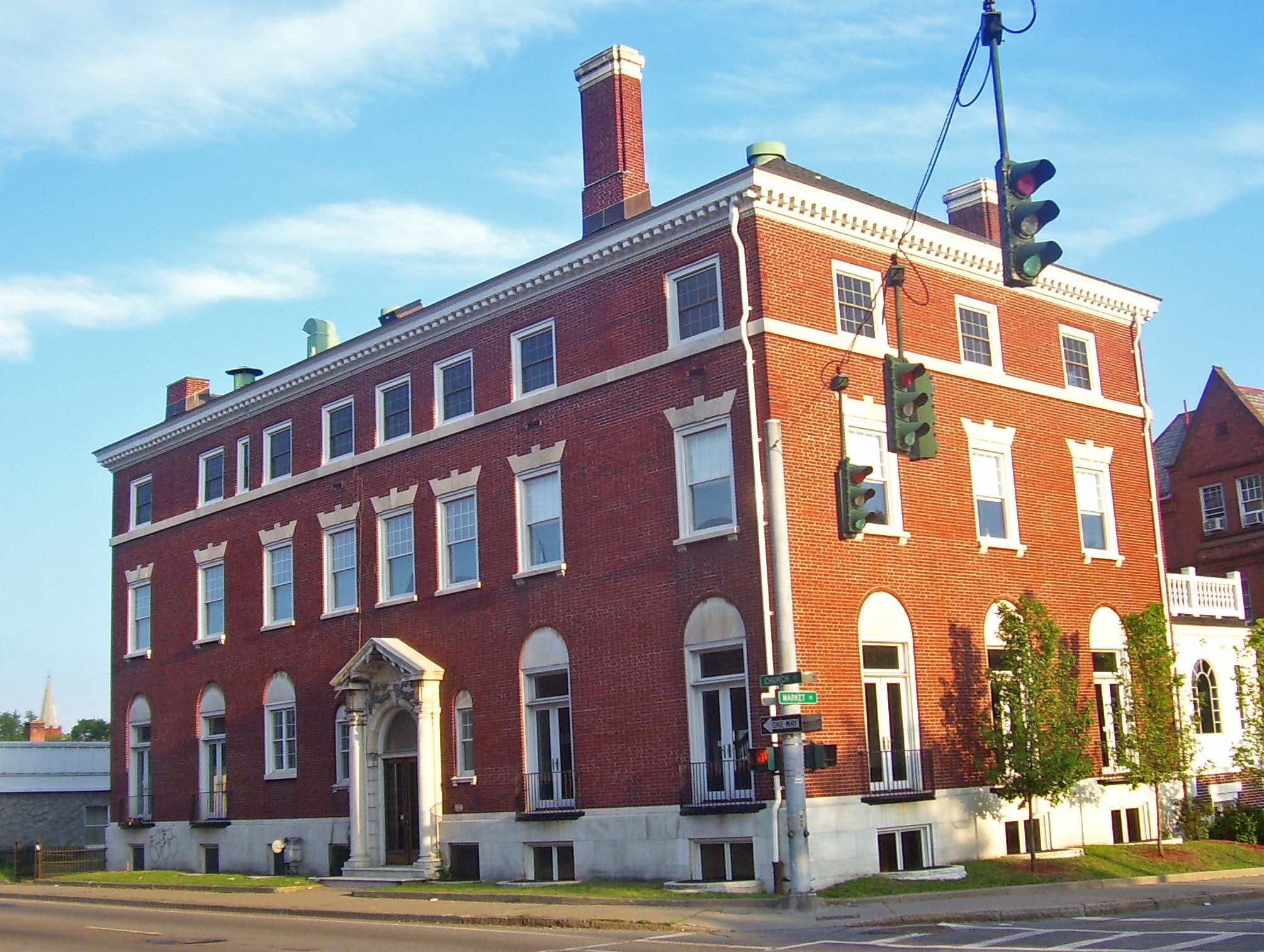- Amrita Club
Infobox nrhp
name = Amrita Club
nrhp_type =

caption = North (front) elevation and west profile, 2008
lat_degrees = 41
lat_minutes = 42
lat_seconds = 06
lat_direction = N
long_degrees = 73
long_minutes = 55
long_seconds = 46
long_direction = W
location = Poughkeepsie, NY
nearest_city =
area =
built = 1912cite web|last=Sharp|first=Townley|title=National Register of Historic Places nomination, Amrita Club|url=http://www.oprhp.state.ny.us/hpimaging/hp_view.asp?GroupView=1755|publisher=New York State Office of Parks, Recreation and Historic Preservation |date=1980-08-06|accessdate=2008-10-09]
architect =
architecture = Colonial Revival
designated =
added = November 26, 1982
established =
visitation_num =
visitation_year =
refnum = 82001119
mpsub = Poughkeepsie MRA
governing_body = Private businessThe Amrita Club building is located at the southeast corner of Church (US 44/NY 55) and Market streets in Poughkeepsie,New York ,United States . It was once home to the club, one of the city's most prestigious gentlemen's organizations. In 1982 it was added to theNational Register of Historic Places (NRHP).The club was established in the late 19th century, but the building was not erected until the early 20th. It is one of only two brick Colonial Revival buildings in the city, and a sophisticated application of that style. Efforts to redevelop it in the early 21st century led to a protracted court battle between the city and a local software company which is now headquartered there.cite web|title=Contact|url=http://www.decisiontech.com/contact/contact.html|publisher=Decision Technologies International|accessdate=2008-10-10]
Building
The Amrita Club is in a very historic neighborhood. It is is across the street from the
Market Street Row , a group of houses that includes Poughkeepsie's oldest frame house, and immediately north of the Hasbrouck House, with theAdriance Memorial Library a few houses down. It is across Church from the armory and across on the opposite corner is theOld Poughkeepsie YMCA . All of these are also listed on the Register.The building itself is a rectangular structure three stories tall, with raised
basement , and eight to nine bays wide by three deep. Its double-doored, centrally-located entrance has a marble surround consisting of columns with sculpted capitals and a dentilledentablature . Below that, the doors themselves are topped with astained glass transom. The whole doorway is further topped with a keystone decorated withfleur-de-lis and ribbons on either side.On either flank of the entrance, the first floor features
French windows and iron balconies, except for the smaller windows next to the door, trimmed with marble lintels and sills. A similar pattern is found on the larger windows of the third story. Above them is a dentilled cornice andarchitrave ; two large chimneys rise from the hipped roof. The rear elevation features two porches with Doric columns.History
The club was founded in 1873 for local businessmen and professionals, with future neighbor and prominent local lawyer Frank Hasbrouck as one of the charter members. It excluded Catholics, African-Americans and Jews, and soon became synonymous with the city's elite. In 1905, local historian Edmund Platt described as "the first club of any importance". "Much of Poughkeepsie's growth was decided at the Amrita Club's dinner table", writes Carolyn Burke in her biography of
Lee Miller , whose father was a member during her childhood.cite book |title=Lee Miller: A Life |last=Burke |first=Carolyn |authorlink= |coauthors= |year=2007 |publisher=University of Chicago Press |location=Chicago, Illinois |isbn=0226080676 |pages= |url=http://www.nytimes.com/2006/01/08/books/chapters/0108-1st-burke.html?pagewanted=all ]It met either in rented rooms or refurbished older buildings until it decided to build its own clubhouse in 1912. It cost the club $100,000 ($formatprice|inflation|US|100000|1912|2008|r=3 in 2008 dollars.inflation-fn)
Over the course of the 20th century, the club's influence waned as the city grew more diverse and its industrial base declined. In the 1980s it eventually disbanded and the building became city property. Unoccupied, it decayed until 1999 when Decision Technologies International (DTI), a software consulting firm based in nearby Wappinger, reached a deal with the city to renovate the building and use it as its headquarters. The city committed $800,000 in urban-redevelopment grants to help the company.cite news|last=Densmore|first=Steve|title=City Pulls Plug on Amrita Club|url=http://www.weeklybeat.net/2002/08/09/citypullsplugamrita.html|work=The Weekly Beat|date=2002-08-09|accessdate=2008-10-10]
In 2002, almost a year and a half after DTI had last withdrawn funds from the account, the city moved to foreclose on the property since it believed DTI was not serious about redeveloping it and it had been approached by others who were. DTI insisted it was serious, and after first threatening to contest any action vigorously, agreed to waive certain defenses in exchange for a 30-day
reprieve . The city formally commenced foreclosure actions early in 2003, with DTI's founder, Idoni Matthews, promising a court fight. In October it began work again, but the city would not withdraw the action.cite news|last=Beasimer|first=Jessica|title=Work Resumes at Amrita Club|url=http://www.theweeklybeat.net/2003/10/10-10-03/amrita.html|work=The Weekly Beat|date=2003-10-10|accessdate=2008-10-10] In 2004 the work was completed and DTI moved its workforce into the building.cite news|last=Densmore|first=Steve|title=Amrita Club Appears to be Back on Track|url=http://www.weeklybeat.net/2004/04/4-9-04/amritabackontrack.html|work=The Weekly Beat|date=2004-04-09|accessdate=2008-10-10]References
Wikimedia Foundation. 2010.
